Well done to all the organisers of the Blackrock regatta! A great sunny day for a great community initiative set amidst the beautiful scenery of the Marina.

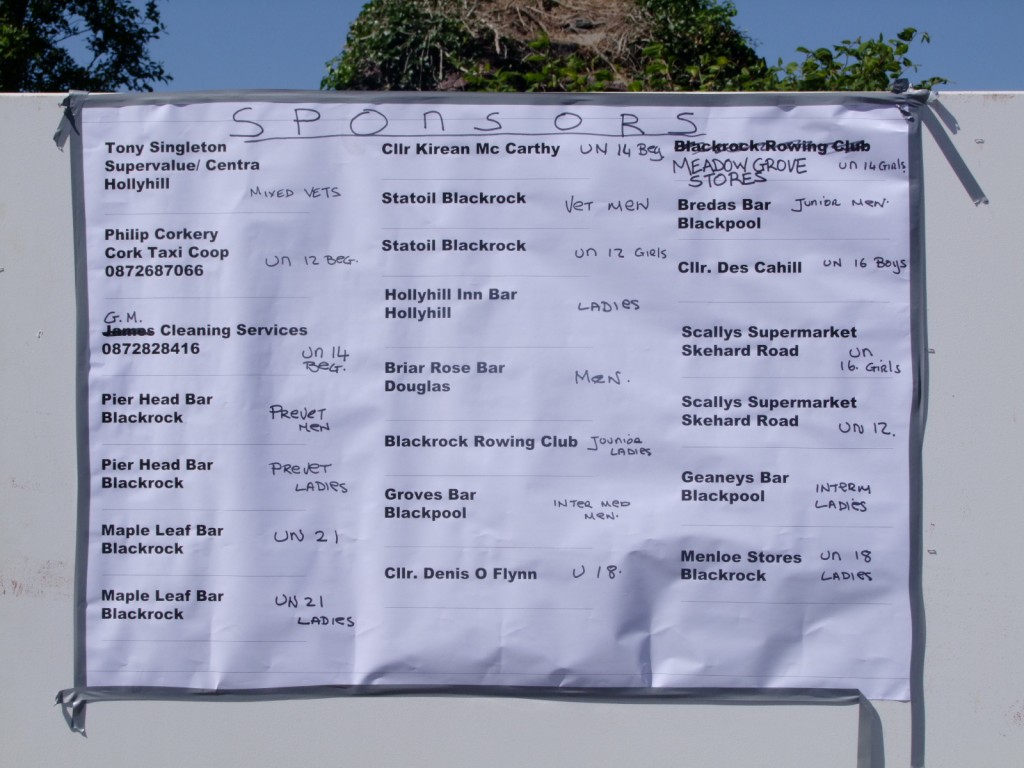





Well done to all the organisers of the Blackrock regatta! A great sunny day for a great community initiative set amidst the beautiful scenery of the Marina.







Kieran ‘s comments, Cork City Council Meeting, 24 May 2010
Re: Kieran’s motion, which came before the City Council meeting, Monday 24 May 2010;
“As an incentive to boost trading in Cork City and to help traders in these difficult economic times, that this Council would offer 2 hours free parking in the Council’s two public carparks on Saturday mornings from 9 am to 11am on a trial period in early spring 2010, a period of time to be agreed upon (Cllr K. McCarthy)”.
Kieran: Despite the E.5 million surplus over the last three years, car parking income is going one way. Over E.500,000 was lost between 2007 and 2009. Over E.180,000 in income was lost in public car parks in 2008/ 09. All of the Council’s public carparks North Main Street and Paul Street, White Street and Park and Ride are losing money. People are not buying into multi-storey carparks and the 1,900 car parks spaces. There is a need for a review and a marketing campaign.
This is a positive proposal for the Council; it is a positive proposal for traders. North Main Street carpark in particular is worst affected. I wish to call for a vote to reject the managers report which recommends not carrying out this proposal.
Kmc: Unfortunately I was outvoted, 17-5 by by fellow councillors.
Kieran’s Motions, Cork City Council, 27 May 2010
Motions:
That a review take place of where the bins and dog fouls bins are in the south east ward with an eye to providing more bins especially to combat dog fouling (Cllr Kieran McCarthy).
To get a report from the Director of Planning on the status of development on vacant land behind St Finbarre’s Hospital on South Douglas Road (western side) adjacent the eastbound bus stop (Cllr Kieran McCarthy).

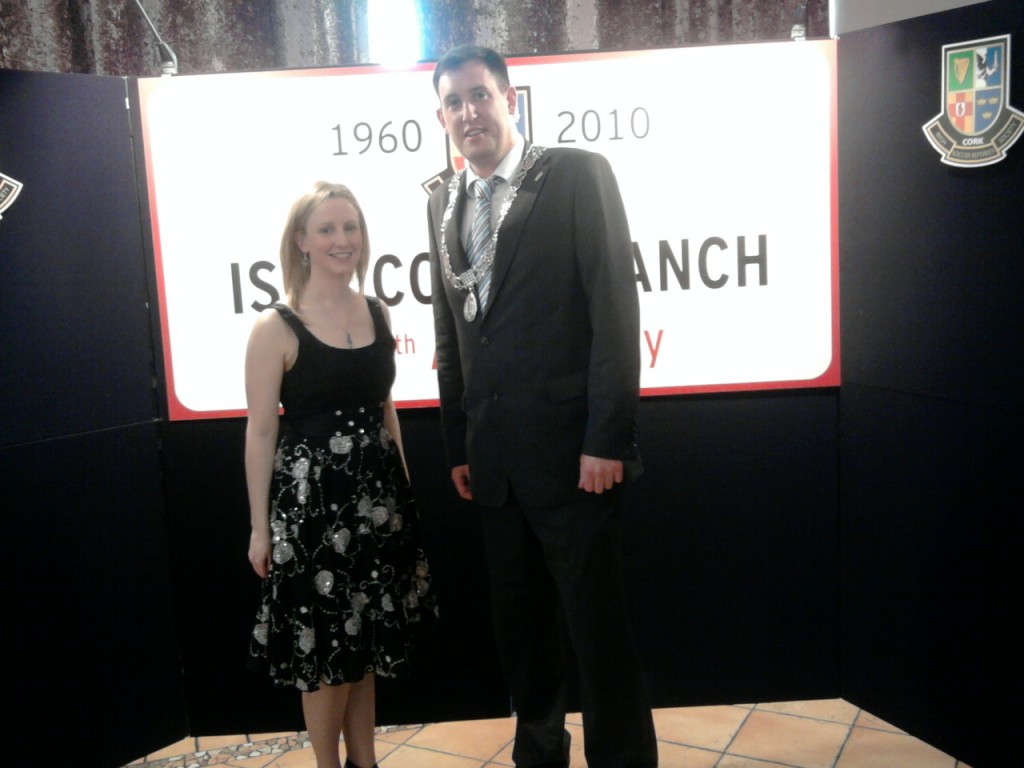
Kieran’s Speech, Deputising for the Lord Mayor
Cork Branch, Irish Soccer Referree Association, 22 May 2010, Rochestown Park Hotel, Cork
“Temporal Voyages”
Chairman, ladies and gentlemen,
Many thanks for the invite this evening. Fifty years is indeed a great milestone and it’s great to see the branch taking time out, taking stock and reflecting on fifty years of hard grafting and building.
I read from your history that you were founded in September 1960. Time is an interesting thing and time brings its own problems and achievements. If one catapults oneself back into that month and begin reading the Evening Echo, one is presented with a very interesting world.
On the international news front, one reads of the Congo republic in its first couple of days after Belgian troops withdrawing. You can read about the space race and the proposed vision of living in domes on the moon and growing the earth’s crops there; the Russians creating Sputnik is featured and a new war was beginning as Communist troops invaded Los in North East Vietnam
The Paris fashion gurus were saying that short hair and big eyes were in and hair colour that could be stroked on your head as it had been invented. And a new Electric Clothes Dryer had also been invented and in the sales pages of the Echo.
If you couldn’t get the newspapers, you could always tune into Radio Eireann, the BBC Home Service, The BBC Light Programmes, the BBC Third Programme, Radio Luxembourg or the American Forces Network.
In Ireland, debate raged on the idea of television as Sweden’s television network got the editorial review in the Evening Echo.
Eamon de Valera had just being elected third President of Ireland. Sean Lemass becoame the new leader of Fianna Fáil and The Irish Congress of Trade Unions is formed. And Ireland began negotiations to join the EEC but failed in 1961.
Wexford was preparing to meet Tipperary in the Hurling final
In Cork, new housing schemes had just appeared in Churchfield and Ballyphehane. Preparations were nearly there for the opening of Verolme Dockyard and Cork Airport;, Gouldings Fertilisers opened as did St Catherine’s Primary School in Bishopstown. fundraising for a new Cork Opera House was still ongoing and Cork City Council was contemplating a Cork Main Drainage Scheme. Clinics were held at City Hall for chest problems and Diptheria immunisation.
The Evening Echo was filled full of sporting reports – filled to the brim with hurling, football, rugby and soccer programmes. And in the midst of all those things going on For September 1960, The Cork Branch of the Irish Soccer Referees Society was founded A.O.H Hall on Morrison’s Island. Twelve members were present;
Sam Alan, Joe Bray, Frank Casey, Jim Mullins, Joe Hurley, Joe Riordan, Owen Mc Carthy, Sylvester Greger, S O Connell, C.Crowley, W Horgan, and Sam Spillane joined latter by other greats such as Derry Barrett and Rory O Conner among others.
And here we are fifty years later, the branch has evolved as the needs of its members changed over time to incorporate what they saw as relevant to the contemporary and future of soccer in Ireland. Each successful season is immortalised in the memories of all those who took part over the five decades and probably numerous photos exist in members’ memory drawers at home.
Any sport is a great thing. Your branch has brought increased professionalism amongst your members but also amongst each player that stands before a game.
In a sense, you have wielded sport and its power to grasp, inspire confidence, self-purpose, provoke questions and the imagination and and so much more. You have also given hope and have no doubt have saved souls.
So ladies and gentlemen there is so much to learn from you.
You have seen much talent, confidence self pride, self belief and a desire to perform their sport, a self purpose and how to create and nurture those traits
Ladies and gentlemen, in this world, we need more of such confidence, pride and belief – we need to mass produce these qualities,
Ladies and gentlemen, we need to continue to build a legacy in our sporting traditions in this city and also continues to present us with the question
– well what are we doing in our own lives to push forward?
Your branch has come this far – fifty years but I have no doubt has more distance run in it. What will your branch look like in fifty years time?, even ten years. We don’t live in 1960 but in another time when ideas once more are needed and true professionals like yourselves are needed to offer leadership.
I would like to encourage everyone to keep fighting, keep setting an example to all of us. I congratulate all the members both past and present on this achievement and wish you well for the next fifty years
And would like to finish with this; if one had an interest in the cinema in September 1960, the theme in Cork’s cinema was also about life
The Palace played the film last voyage, the Savoy, Never Let go, The Lee cinema, The Earth is mine,
If you wanted a piece of Heaven – well the Capitol played Samson and Delilah but if you wanted Heaven with a bit of an alternative, well there was the film The Hot Angel playing at the Colliseum
And if you wanted you wanted to know what hell was, well the Pavillion played Hell is a City
Many thanks for the invite and enjoy the evening.
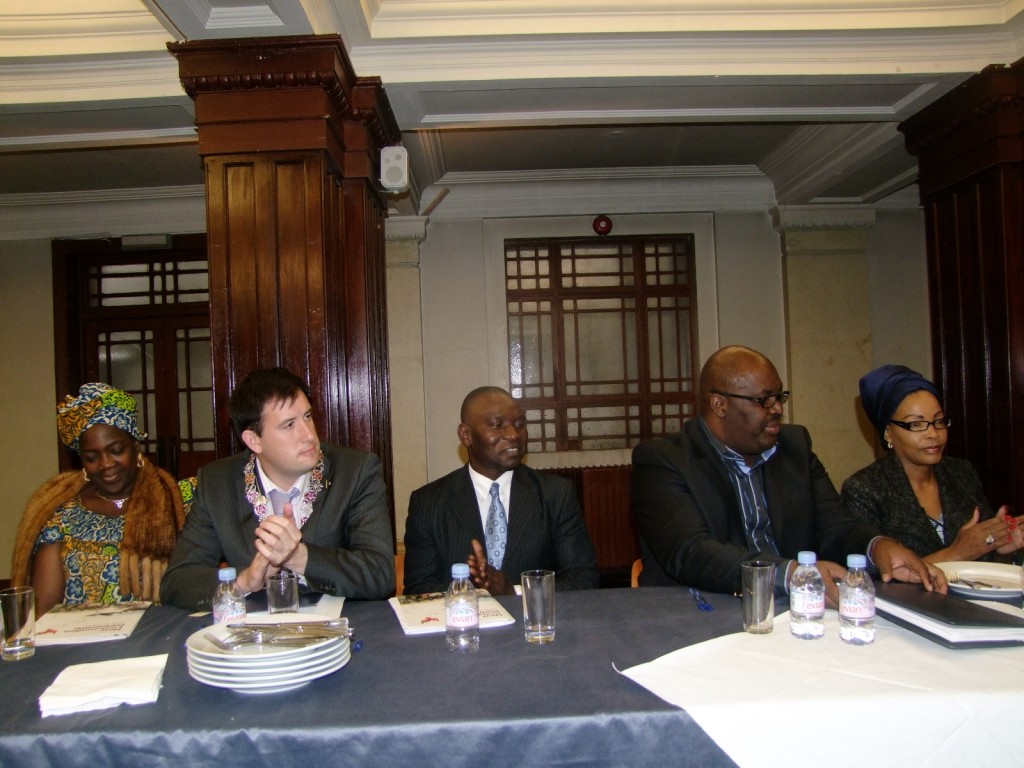
Kieran’s Speech, Deputy Lord Mayor, Conference, Africa in the 21st century, Cork City Hall, 21 May 2010
“A New Scramble for Africa”
Ladies and gentlemen,
Many thanks for your invitation this morning.
I’m going to start with a confession. I’m a born and bred Corkman. You’ll hear it my accent. My DNA is bound up with this windswept Atlantic facing city. My views –convictions, education, beliefs, values, traditions and outlook are bound to Ireland’s second city and its place in Ireland, an island rock within Western Europe.
I’m a historical geographer by trade and have an interest in how people interact with places. I’m an avid fan of the power of cultural heritage, education and the development of peoples’ talents. I have never been to Africa, even though I went to Cork Schools that were big into supporting the missionaries in African countries and the age of Live Aid.
I grew up in a time when migrant influx into Ireland was minuscule and globalisation certainly was not a major issue as it is today. Of course that has all changed rapidly in the Ireland of today.
I have never been to Africa and since I got elected I have had the opportunity to listen more to African citizens now resident in Ireland. I always think that everybody has a story to tell and that everybody can contribute to our society if they so wish. Reading up on the challenges faced by Africa today, I was intriqued by the quotes of Kofi Annan of the United Nations that seem to pitch many questions for debate on the future of Africa.
I quote:
· “No society can develop without focusing on three pillars:
1 Security and safety for the population
2 Economic and social development
3 Respect for the rule of law and human rights”
· “Some crimes are so shameful, and shame us all, that we cannot attribute it and leave it to others to respond and that we all have to act”
· “Almost every [African] government is now elected; communication is making a difference; civil society is becoming very active; and people know their rights, are beginning to understand them and are demanding them”
· “The poor don’t really want a handout. They want to trade themselves and work themselves out of poverty”
· “[Global warming] is having a real impact on communities and individuals [in Africa]; either by sustained drought, water stress, or changing weather patterns that destroy agricultural production
· “Africa is changing, the momentum is building in the right direction, and we should help them move on”
And one from Bob Geldolf
· “I think there is no doubt there is a new scramble for Africa underway”
These are all broad themes which range from physical developments to the nature of what government should do to democracy to the nature of community to the human condition itself. The canvass is enormous with different physical geographies with an enormous population .
The last decade of the 20th century seems to bring much hope. The last African colony, Namibia, became independent at the beginning of the last decade, majority rule was established in South Africa, and there was a revival of democracy in many parts of Africa.
Perhaps more so than ever there is a global demand that peace, prosperity and cultural revival will emerge in Africa, or is used to draw attention to the need for such an evolution. However, the continuing Darfur genocide, manipulation of elections or completely ignoring the elections or the outcome of elections by some leaders diverted Africa’s attention from more urgent issues of civil wars, AIDS, malaria, and education.
At the moment, Africa is the only continent where poverty is on the rise. Over 40% of the people of sub-Saharan Africa live below the international poverty line of US$1 a day. Africa’s share of world trade has plummeted, accounting for less than 2%. More than 140 million young Africans are illiterate, and Africa is the only continent where the number of children out of school is rising.
Africans in both the Diaspora and the continent have entered the 21st century still confronted by the hard realities of entrenched poverty, general underdevelopment, death from curable diseases, illiteracy, international marginalisation, and questions over prospects for rates of growth and development that will close the gap between themselves and the rich countries.
Africans on the continent and in the Diaspora are today confronted by a world of financial, investment, and trade regimes which unfairly favour the developed world and which prevents them from improving their quality of life. Skewed investment patterns, unfair trading systems, and a gross imbalance in terms of access to productive capital continue to undermine development efforts in the African and developing world.
Investment in peace, health and education are recognized by many African leaders as essential elements for economic and social emancipation to make the 21st century the African Century. In order to generate sustainable progress, there needs to improvements in the dialogue and actual resolutions between continents
Being responsible seems to a key issue in resolving any debate on Africa. But being responsible brings its own issues. I broke the word Responsible into its constituent parts and came up with the following.
R – real life issues involved
E – energy needed to deal with issues
S – society and its complex processes
P – parts, different parts of the process
O – opportunities that arise
N – negotiations needed
S – strategies needed
I – ideas needed
B – Unknown
L – levels that change need to occur on. Local, national & international
E – empowering needed to get the process moving
However, even if one takes all these steps you may be presented with further steps; As Nelson Mandela notes:
“After climbing a great hill, one only finds that there are many more hills to climb.“
But perhaps we all have to start somewhere. When the fire of debate and hope goes out, then we have larger problems with our own souls,
They are just are a few points. I wish you well this morning in your discussions and debate and many thanks again for the invitation.
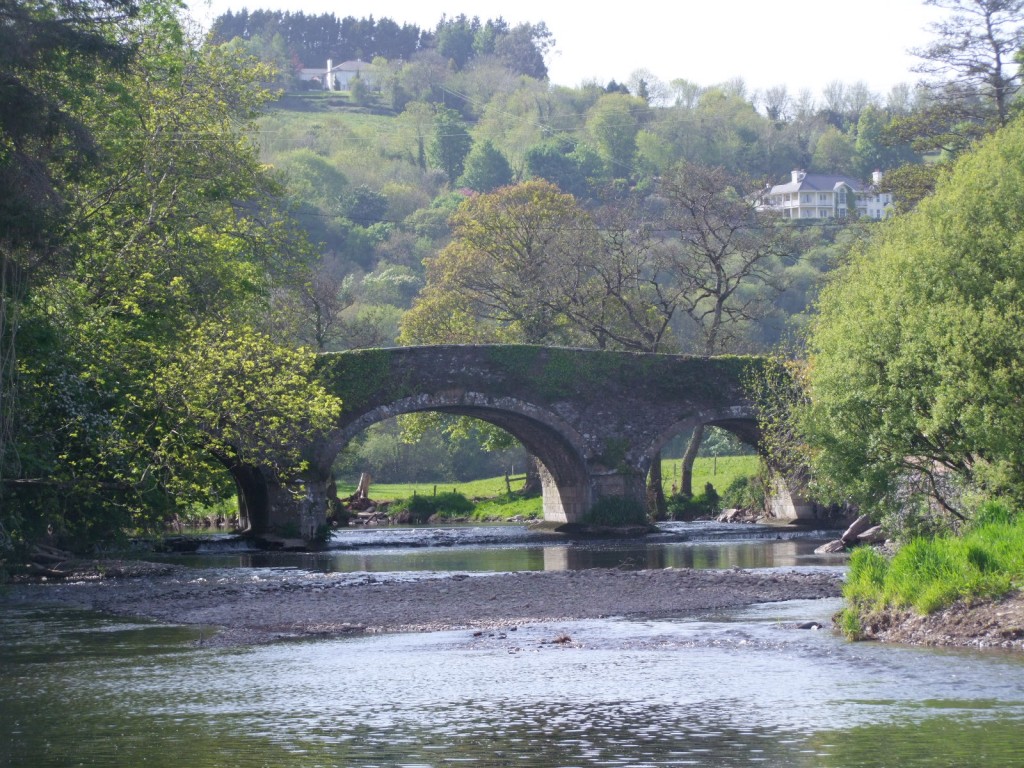
The Pearls of Carrigrohane
“At the foot of the limestone rock, which constitutes the base of the building, is a cave, which the peasantry say, extends several miles underground, and communicates with the great caverns at Ovens, four miles distant. The River below this flows deep and darkly. In its waters is frequently found the Mytilus Margaritiferus or pearl muscle. Indeed at the very source of the River at Gougane Barra, large quantities of the fish may be procured, and it is known that the Mytilus may be made to produce pearls by artificial means” (John Windele, 1846, Guide to the South of Ireland, p.255).
I have in passing in my entrances and journeys into the countryside of the Lee Valley admired a number of elements in the Carrigrohane area. Perhaps first and foremost for me the large and imposing number of human monuments such as the castle, church and bridges all reveal a tapestry of enduring stories. These, I feel, are captured and frozen in time between the busyness of Cork City’s western suburbs and the satellite town of Ballincollig. I have also stopped adjacent to the three limestone arched Leemount/ Carrigrohane Bridge at the Angler’s Rest. I have delighted in the swirling of the Lee below and the adjoining and spreading out pastural farmlands on the Lee’s floodplains. From here at different times of the day and year, Carrigrohane Castle appears in a different light continuously provoking the viewer to gaze and cherish.
In this part of the Lee, I have seen many a fisherman cast their line into the water and standing like statues, or as I always think like ambassadors standing to welcome the river to their area. Through the name Angler’s Rest, the pub draws attention to a way of life on the river. The joining of the Shournagh River to the Lee marks another milestone in the geography of the Lee Valley and makes for remarkable scenic views for those as my grandmother used to say who cast “one eye up the Shournagh”.
From historical sources, I have not been the first to stop adjacent Leemount/ Carrigrohane Bridge and reflect on this world. John Windele describes this part of the valley and adds his own colour to the memory of the landscape. He attempts to validate the beauty and sanctity at this spot by drawing on local folklore (p.255); “At a sudden bend of the River, is a deep pool, bearing the fearful name of Poul –an Ifrinn, or Hell-Hole. It is overhung by high limestone precipices, and from its neighbourhood, a highly beautiful view of the Castle is obtained. One of those fanciful eels of the supernatural class is said to inhabit this part of the river; he is of monstrous dimensions, has a mane of hair like a horse and two short feet. He is the guardian of enchanted abodes beneath, containing vast treasures. Heretofore, he often at night, quitted the waters, ad his track might be seen in the morning on the neighbouring grounds, but of late years, his visits have been rare as those of Angels.”
Samuel Lewis in his Topographical Dictionary of Ireland also comments on Carrigrohane. Circa 1835, the area contained 1921 inhabitants. He describes that the parish is situated on the south bank of the river Lee. Over the Lee was a stone bridge connecting it with a new line of road from Cork City into the heart of Inniscarra and eastwards through Magourney in Coachford to Macroom. This seemed to be part of a wider project at the time to improve access to the western approaches of the City. Another bridge was built over the River Shournagh as it enters the Lee. The Lee in Carrigrohane also powered a set of water wheels connected in a flour mill, which manufactured from 350 to 400 sacks of flour weekly. The mills offered local employment as did the Gunpowder Mills in Ballincollig.
Samuel Lewis notes of the land as of excellent quality, and the farms, being in the occupation of people with money, were in an excellent state of cultivation. From the low price of grain, the produce of the dairy and the grazing of cattle had been found more profitable than growing corn. The lands were therefore being converted into dairy farms. In addition Samuel Lewis points out that the parish forms part of the limestone district that extends from near the source of the River Bride, along its southern bank [through Ovens], across the vale to the west of the city of Cork, and passing through its southern suburbs, terminating at Blackrock. Lewis describes that the quarrying of limestone can be seen in the “comfortable appearance” and the improved state of the habitations of the local population.
An impressive structure that has survived the test of time and also one of the keys to unlocking the history of the region rests further is the Church of Ireland monument of St. Peter’s Church. The church in 1837 was a small plain edifice to which the Ecclesiastical Commissioners had granted funding for repairs to the amount of £143. It is said that the original church was built in the seventeenth century.
To be continued…
Captions:
540a. Bridge over the Shournagh River as it enters the River Lee near the Angler’s Rest, Leemount, May 2010 (pictures: Kieran McCarthy)
540b. Leemount/ Carrigrohane Bridge, May 2010

20 May 2010
Dear Resident,
The Darren Swanton Memorial Rallysprint is taking place on Sunday the 30th of May this year at the Cork City Civic Amenity Centre on Kinsale Road . Organised and promoted by Cork Motor Club Ltd., in association with Cork City Council and the Bishopstown and District Lions Club, the event aims to raise money for the Marymount Hospice.
Darren was a 30 year old member of the Cork Motor Club who died of cancer in Marymount in 2009. Taking place on the site of the former landfill on the Kinsale Road, the event will see around 100 cars participating on the day. The event will also host a fun fair onsite and there will be food outlets, merchandisers, etc., to give the day a real family feel. The first timed run will start no earlier than 10:00, with the proceedings scheduled tofinish at 18:30 approx.
This event will be run subject to the permission of Cork City Council, the Gardai, Cork Fire Service and representatives of the HSE. A permit has been granted by the relevant authorities to cover same. As the event will be run fully within the boundaries of the Cork City Civic Amenity Centre, no road closures shall be required, and the disturbance to the residents will be kept to a minimum.
I would encourage you to come along on the day, and see for yourself the spectacle of motorsport that is planned, for what is ultimately a very worthy cause. Should you have any queries or concerns regarding the event, please do not hesitate to contact me on 086 836 9091.
Yours faithfully,
Finian Toomey
Event Manager

Kieran’s Speech
“Survival “– St. Joseph’s Cemetery, Cork
16 May 2010
Chairman, Local historian Ronnie Herlihy, ladies and gentlemen.
Thanks very much for the invitation to speak here this afternoon at St. Joseph’s Cemetery
It is said that remembering is the work of the living and I feel that looking around at the beautiful headstones in this graveyard highlights that sentiment.
Remembering is argued as a thoroughly social and political process, that remembering is always bound up with contestation and controversy.
The past tends to be constantly selected, filtered and restructured in terms set by the questions and necessities of the present.
So remembering is also linked to about the inclusions and exclusions of modes of memory and actual memories.
For such an enormous event, the memory of the famine in the Cork region has been put to one side in the way of life of its people. However, when it is brought up, as seen in the multiple published works in our local history libraries, huge questions on this era are raised and how the Famine transformed localties and ultimately affected society across the spectrum of the Irish landscape.
The memory of the Great Famine is both sensitive and compelling. There are many threads of its history to interweave – the political, economic and social framework of Ireland at that time plus the on the ground reality of life in the early 1800s – family, cultural contexts, individual portraits.
In the present day history books in school, the reader is drawn to very traumatic terms. The recurring visions comprise potatoes blackened, rotten, wasted, the human destruction, appalling, tragic, stretched bodies, trauma, devastation, sorrow, harrowing, holocaust-like, loss, exile, suffering, eviction, poverty, starvation, perishing, disease, lethal fevers. One can see why the Great Famine is more on the forgetting list than on the remembering one.
Perhaps this traumatic event has been silenced. When it does appear, it has the appearance of a type of folk status. Selected memories of memories in a sense appear, which provide some bridging of remembering and forgetting. Standing here, there is much to think about –
Life itself and the human experience.
A total of one million individuals died as a result of hunger induced illnesses. As seen through the many gravestones here, many people are buried here and looked after by their relatives. The Famine plot has countless poor souls.
The scattering of bodies lie in graveyards across the Irish countryside. Numbers can range from eight to ten thousand people – from here to Carr’s Hill on the road to Carrigaline.
Hundreds of thousands were forced to emigrate to survive. Famine folklore attests to “American wakes”, “coffin ships,” the move to whole new worlds where survival was even more difficult in big emigrant cities such as Liverpool and New York. Then, one reads about a certain shame associated with leaving and other terms appear in the history books such as community shunning, silence and abandonment. However, over one million emigrated creating an enormous international diaspora.
I think landscapes such as this in St Joseph’s Cemetery serve as a vast repository of narratives, memories, symbolism, iconography and cultural debate.
There is so much to explore and so much history and heritage we can harness in our modern world for survival. Despite the traumatic experience encountered, such tragedies can bring people together, help build a better vision and future.
Ladies and gentlemen, in this world, we need more of such building and vision.
Ladies and gentlemen, now is our time to build our legacy and presents us all with the question
– well what are we doing in our own lives to push forward?
On behalf of the Lord Mayor I wish to thank the organisers for the invitation to attend and to speak. I wish the committee continued success.
see the following video from Richard T. Cooke and Catherine Courtney for more:
http://www.youtube.com/watch?v=STx5GXzcwtA
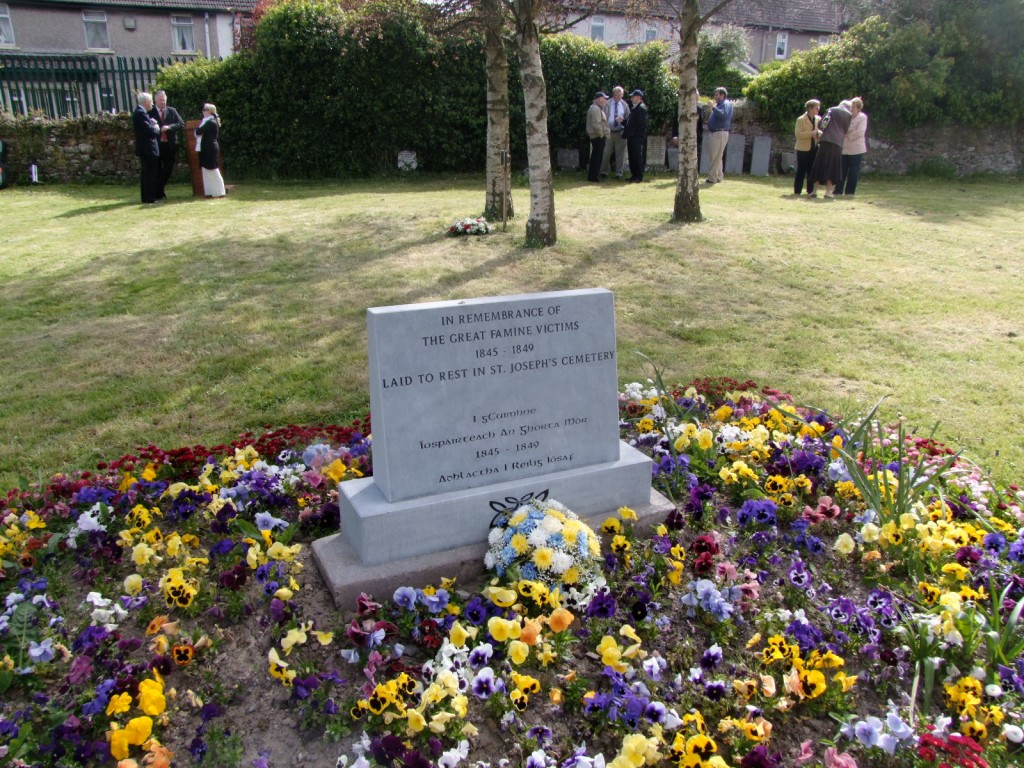

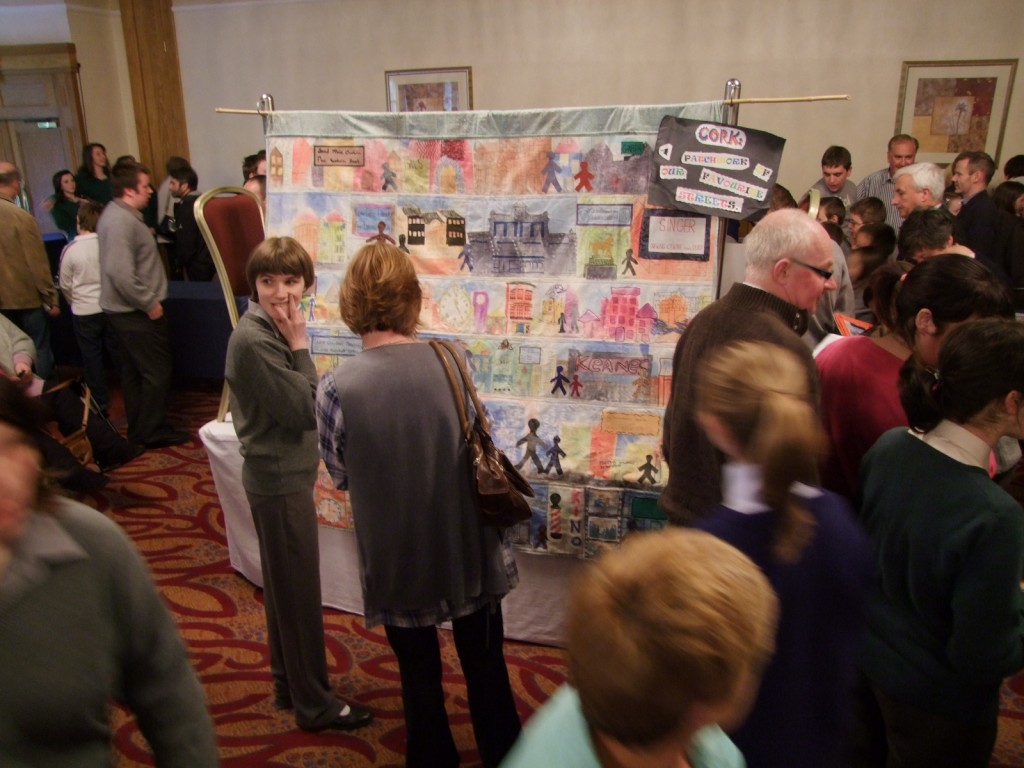
Kieran’s Our City, Our Town Article, Cork Independent
Discover your Area
Another year and another great set of projects by Cork students. This year marks the eighth year of the Discover Cork: Schools’ Heritage Project co-ordinated by myself. The Project is open to schools in Cork; at primary level to the pupils of fourth, fifth and sixth class and at post-primary from first to sixth years.
One of the key aims of the project is to allow students to explore, investigate and debate their local heritage in a constructive, active and fun way. Projects on any aspect of Cork’s rich heritage (built, natural and cultural) can be submitted to an adjudication panel. Prizes are awarded for best projects and certificates are given to each participant. A total of 28 schools in Cork City took part in the 2010 Project. Circa 900 students participated in the process. Approx 180 projects were submitted on all aspects of Cork’s heritage.
The standard was very high this year. The top prizes, 60 in all, were given to students’ projects, which took a clever approach to the topic. Much of the work could be published as local heritage / history guides. The methodologies that the students provide interesting ways to approach the study of local heritage.
Submitted projects must be colourful, creative, have personal opinion, imagination and gain publicity before submission. These elements form the basis of a student friendly narrative analysis approach where the students explore their project topic in an interactive and task oriented way. In particular students are encouraged to attain primary material generating primary material through engaging with fieldwork, interviews with local people, making models, photographing, cartoon creating, making DVDs of their area. Re-enacting is also a feature of several projects.
Students are to experiment with the overall design and plan of their projects. This year thirty per cent of the marks went towards making a short film on projects. This brought the overall project towards ideas of phenomenology and looking at topics as phenomenons within the student’s world. It brought the student to become more personal and creative in their approaches.
The submitted DVDs this year had interviews of family members to local historians to the student taking a reporter type stance on their work. Some students also chose to act out scenes from the past. In general this DVD brought up the standard of the personal response by students and also engaged other family members and friends to help out, whether that be sourcing a camera or helping with scripts and ideas or helping with editing of films on computers.
The creativity section also encourages model making. All models are referred to in the project book. The student must describe why and how they put the model together. The best model trophy in general goes to the creative and realistic model.
Students are encouraged to compare and connect the past to their present and their immediate future. Work needs to involve re-imagining what life may have been like. One of the key foundations in the Project is about developing empathy for the past and to try to link the present to the past – to think about attitudes and experience in the past. Interpretation is also empowering for the student- all the time developing a better sense of the different ways in which people engage with and express a sense of place and time.
Students’ opinions are very important to the overall aims of the project. The inclusion of opinion is about personalising your project. Any text taken from books and the internet needs to be the students’ own words (as far as possible).Personal commentary is to appear throughout the project.
Every year, the students involved in the project produce lots of project books and do enormous work getting the information from the local community. This section is about showing the student’s work to the wider community. It is about reaching out and gaining public praise for the student but also appraisal and further ideas. This year the most prominent source of gaining publicity was having parents into the classroom for an open day for viewing projects. Students were also successful in putting work on local parish newsletters, newspapers and local radio stations and also presenting work in local libraries.
Overall, the Discover Cork: Schools’ Heritage Project attempts to provide the student with a hands-on and interactive activity that is all about learning not only about your local area but also about the process of learning by participating students. The Schools’ Heritage Project also focuses on motivating and inspiring young people. The Project attempts to build a new concerned generation of Cork people, pushing them forward, growing their self-development empowering them to connect to their world.
The project in the city is kindly funded by Cork Civic Trust (viz the help of Mr. John X. Miller), Cork City Council (viz the help of Ms. Niamh Twomey), the Heritage Council and the Evening Echo. Prizes were also provided in the 2010 season by Sean Kelly of Lucky Meadows Equestrian Centre Watergrasshill, the Lifetime Lab, Lee Road (thanks to Meryvn Horgan) and Cork City Gaol Heritage Centre. A full list of winners, topics and pictures of some of the project pages can be viewed at www.corkheritage.ie
Captions:
539a. View of creative quilt depicting the streets of Cork by students of Scoil Bernadette (pictures: Kieran McCarthy)
539b. View of winning model by Julianne McGowan, Our Lady of Lourdes National School, Ballinlough with Lord Mayor of Cork, Cllr. Dara Murphy, John X. Miller of Cork Civic Trust, Niamh Twomey, Heritage Officer, Cork City Council and Cllr Kieran McCarthy, co-ordinator.
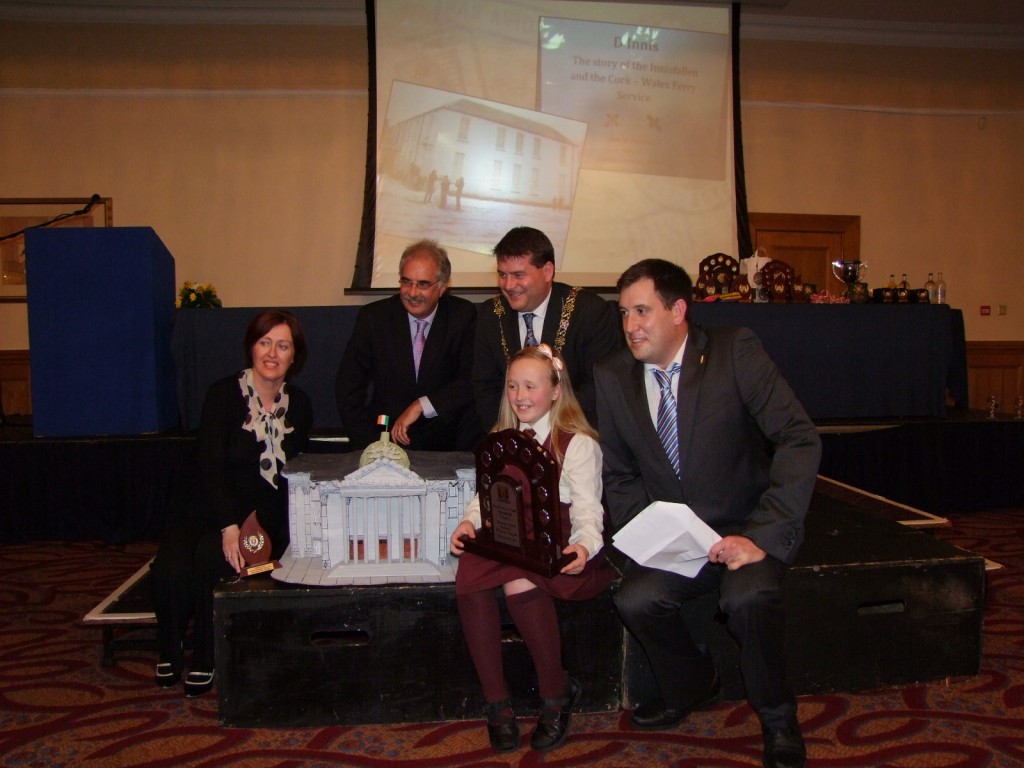
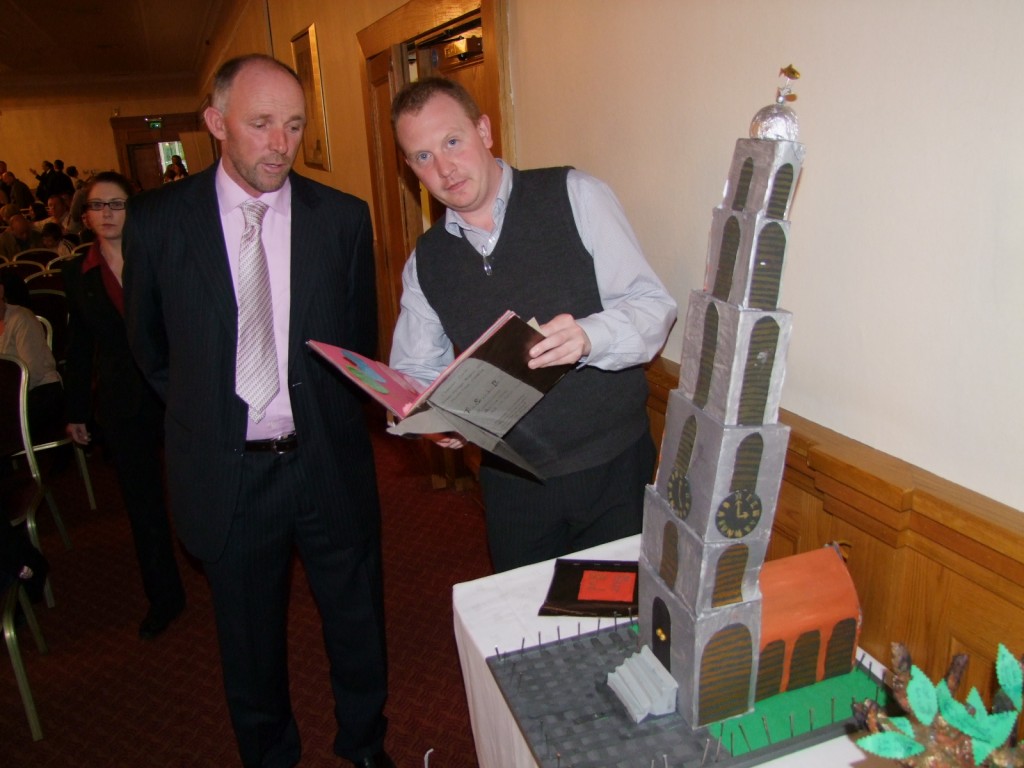
Winners Announced – Discover Cork: Schools’ Heritage Project 2010
Founded in the school year 2002/ 2003 by Kieran McCarthy, the year 2010 marks the eighth year of the Discover Cork: Schools’ Heritage Project. The Project is open to schools in Cork; at primary level to the pupils of fourth, fifth and sixth class and at post-primary from first to sixth years.
A total of 28 schools in Cork City and 25 in Cork County took part in the 2010 Project. Circa 900 students in the city participated in the process with approx 45 hours of workshops delivered. Approx 180 projects were submitted on all aspects of Cork’s heritage. The project in the city is kindly funded by Cork Civic Trust, Cork City Council, the Heritage Council and the Evening Echo. Prizes were also provided in the 2010 season by Sean Kelly of Lucky Meadows Equestrian Centre Watergrasshill, the Lifetime Lab and Cork City Gaol Heritage Centre.
Commenting, co-ordinator of the project, Cllr Kieran McCarthy noted:
“One of the key aims of the project is to allow students to explore, investigate and debate their local heritage in a constructive, active and fun way. The Project attempts to provide the student with a hands-on and interactive activity that is all about learning not only about your local area but also about the process of learning by participating students. The Schools’ Heritage Project also focuses on motivating and inspiring young people”. A full list of winners for 2010, topics and pictures of some of the project pages can be viewed at www.corkheritage.ie